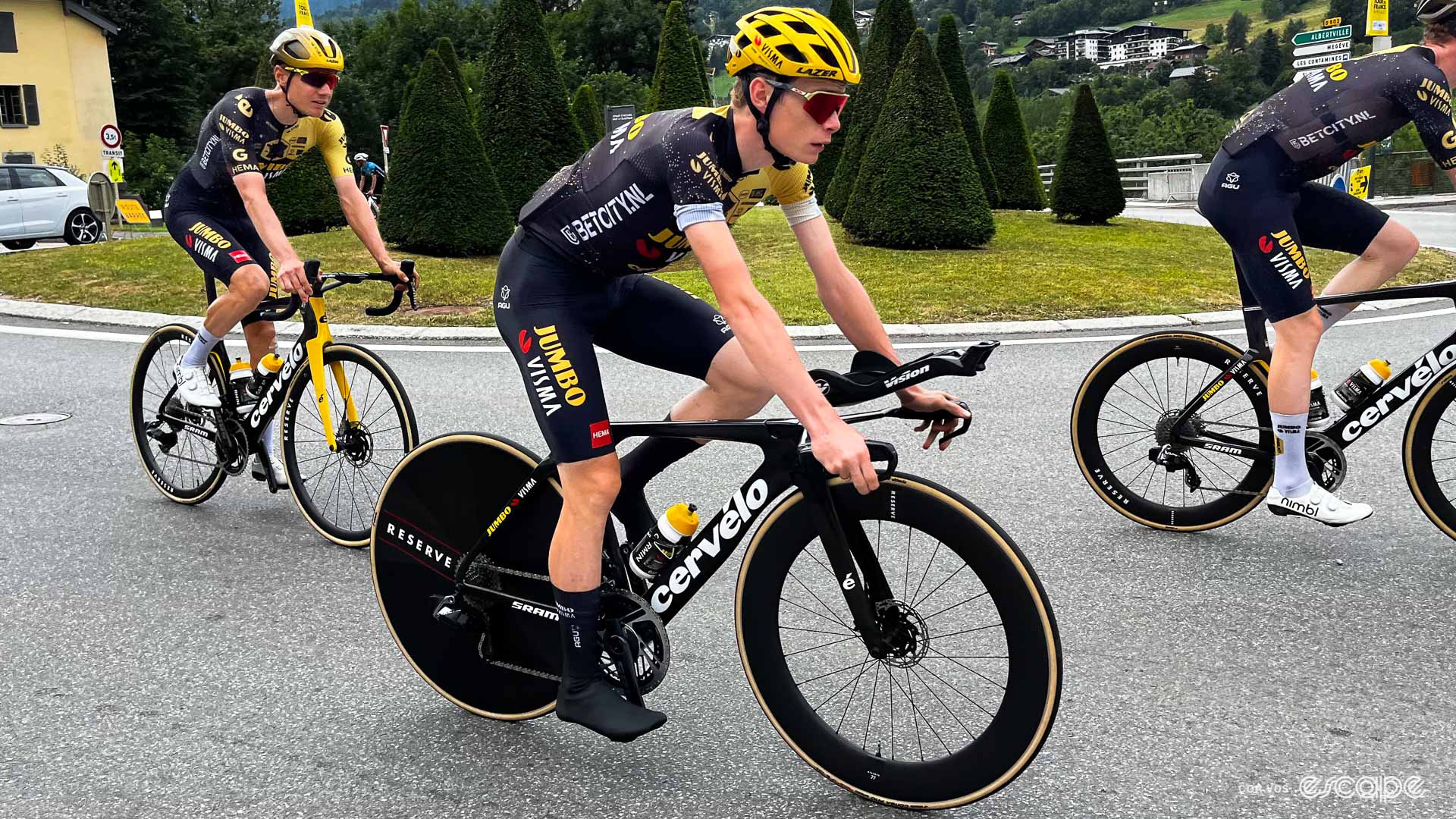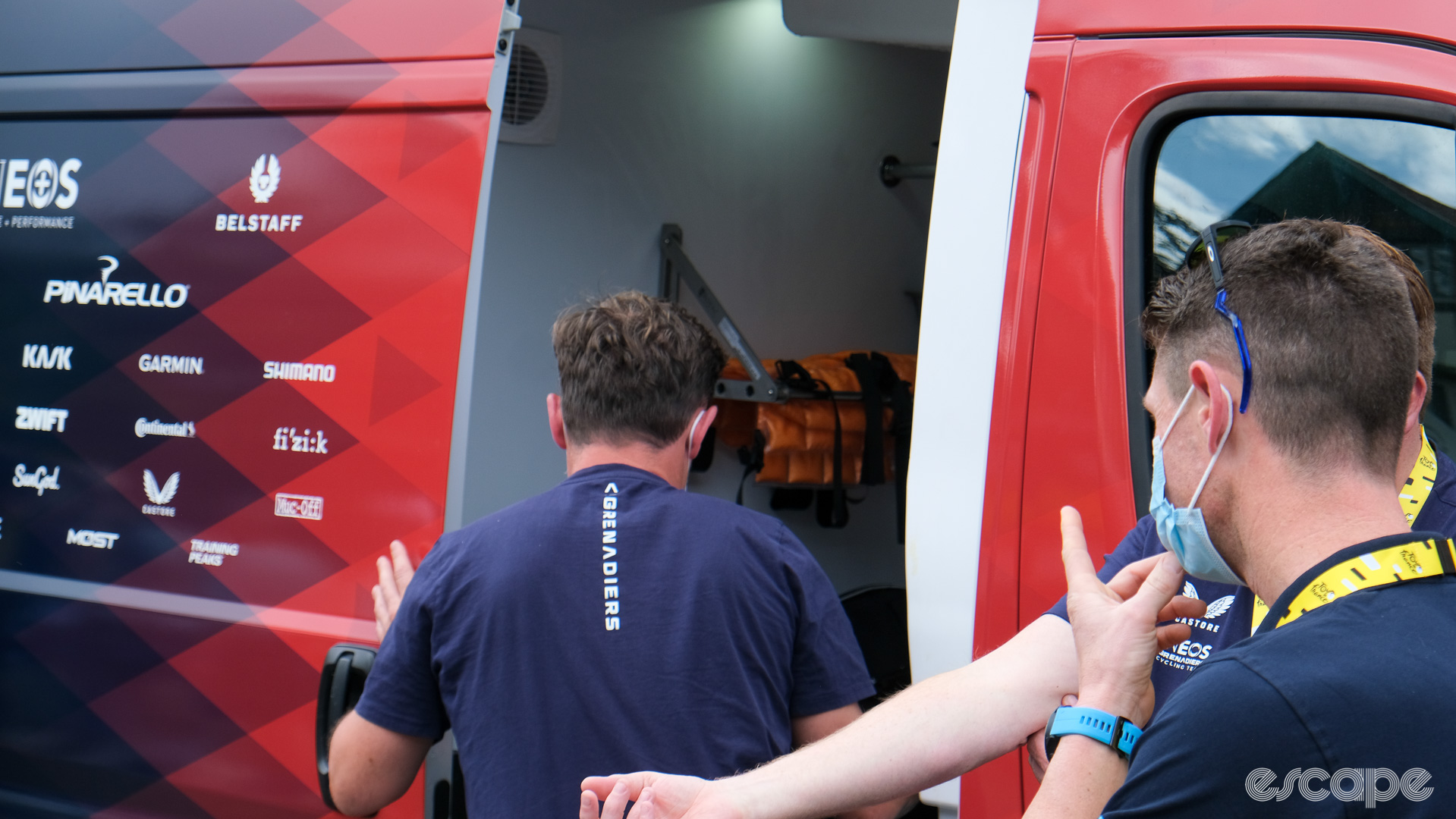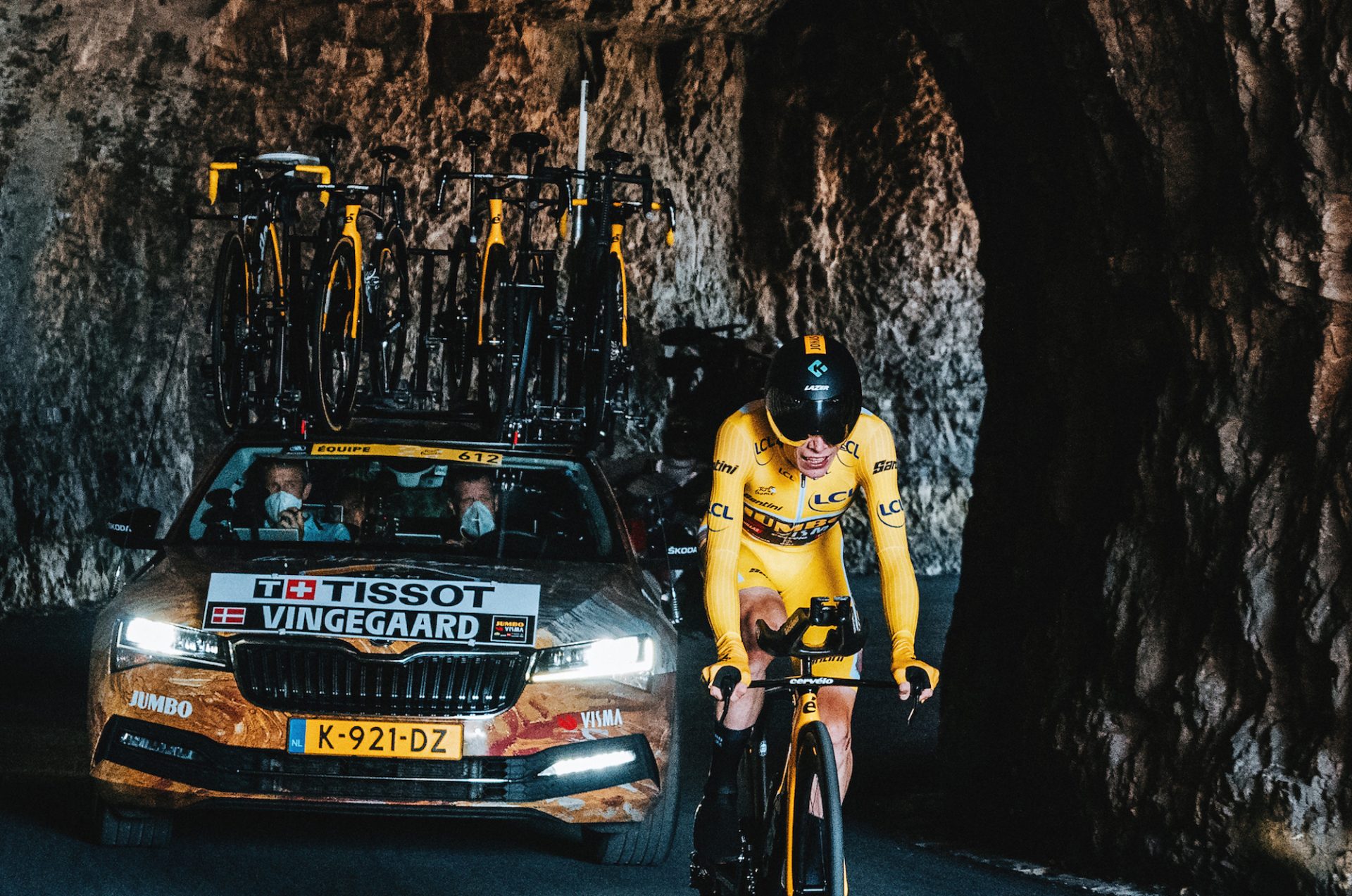I woke up this morning with the idea of writing a time trial preview. It’s a fascinating time trial that could well prove decisive in the overall. Tadej Pogačar and Jonas Vingegaard are inseparable in the mountains and it’s almost impossible to pick a winner in the time trial. On the one hand, Vingegaard is perhaps the slight favourite given the nature of the effort, his ability to ride back Pog’s attacks, and his proven time-trialling ability, but on the other, this is an uphill time trial in the final week of the Tour de France and we all know Pogačar’s track record in such events.
With just ten seconds between them, neither can afford to leave anything to chance. No stone unturned, as the old saying goes. So, instead of writing that preview, I decided to take a look at a few of those stones those chasing TT success will be turning as they prepare for what could be the a Tour de France deciding ride.
Course knowledge
The course for the stage 16 time trial is as fascinating as the battle for overall honours this year. At 22.4 km, it’s hardly a “long time trial” by any stretch of the imagination, but with 636 m of elevation gain, the Cote De La Cascade de Couer (1.3km at 8.5%) and its technical descent, the Cote De Domancy (2.5km at 9.5%) and a sustained drag to the finish line it is anything but straight forward.

A course preview done by Ben Norbury and the folks at MyWindSock, a web app developed to provide descriptive and insightful weather data for time trial course, shows that “gravity plays a larger role than air resistance on this course.” As the MyWindSock course preview put it, “this is a hilly TT that will suit climbers better.” As Ben sees it, Wout van Aert is the only TT specialist with a chance at victory on this course.
The course is just one element of tomorrow’s stage, though, the weather can be equally, sometimes more, of a factor. With thunderstorms forecast, the riders will be hoping first and foremost for good weather and secondly that everyone gets the same conditions.
Several pro teams are already working with MyWindSock and the others likely have similar course and weather modelling software at their disposal. But it’s how the weather interacts with the course which is perhaps most fascinating.
Jumbo-Visma is one team I have observed “aero mapping” time trial courses during the morning recon in previous Tours de France. Jumbo has used a Streamlines Cirrus aero sensor for this purpose on at least one Tour de France time trial in 2021. The primary use for the sensor is measuring aerodynamic drag (CdA), but it can also map the wind speed, direction, and yaw angles on the TT course, on TT day, and on the bike. Weather stations are typically situated ten metres above the ground, so their data isn’t ideal for predicting time trials. This “aero mapping” provides teams with much more relevant data and enables them to optimise their equipment selection for a given course on a given day.
Take wheels, for example: if the team analyses the course and finds the most prevalent yaw angles on the course somewhere between 7-10° and knows from prior testing that Wheelset X stalls at 6° and above while Wheelset Y actually starts producing a sail effect at higher yaw angles, all of a sudden wheelset selection becomes a lot easier.
Aero efficiency
Speaking of wheel selection, equipment selection in general will be critical for stage 16. Optimising for flat time trials is somewhat “easy”: go all in for aero, with weight only a minor concern at best. A hilly time trial like this year’s Tour test presents a whole series of optimising headaches for the teams. As we already seen, gravity (weight) is the primary force to overcome in this time trial, but aerodynamic drag is a very close second. How does one optimise aero in a weight-critical event?
“Do we do a bike change?” will be the question on a lot of the teams’ lips in the build-up to this time trial. A time trial bike will be significantly faster through the valley, but a road bike is lighter and typically riders can produce more power in their road positions, so that may be quicker up the climb and to the finish. But a change could cost ten seconds if everything goes well.
Marc Graveline, an aero consultant who has worked with multiple teams, perhaps summed it up best in explaining that a rider who can produce 20 watts more on their road bike, isn’t just going 20 watts faster, as the lower weight of the road bike is also worth approximately five watts per kilogram saved. 25 to 30 watts on that 2.5 km at 10% will be significant.

So is a bike change quickest? This course is truly borderline, and so the answer is far from simple. John Buckley of Streamlines ran a course simulation for Escape Collective. His results show how rider- and bike-dependent even a bike change can be, with much of it coming down to how efficient and effective a rider is on a climb on the TT bike.. Buckley estimates a rider with only a 10-watt drop in the time trial position, with a light-ish time trial bike, and a 0.06 increase in CdA – in other words, a highly efficient and optimised time triallist – only stands to gain three seconds by switching to a road bike. On the other hand a rider who can produce 20 watts more in his road position has a 1.5 kg-lighter road bike (compared to his TT bike), and limits the aero penalty to a 0.04 increase in CdA, stands to save 32 seconds by switching to the road bike.
Looking at the “big two” we know Primoz Roglic’s Cervelo P5 weighs 8.18 kg. Presumably, Vingegaard’s will be similar. Given the UCI weight limit of 6.8 kg also applies to time trial bikes, Vingegaard likely doesn’t have 1.5 kg to save by swapping to his road bike. We don’t have a weight for Pogačar’s new TT1 Colnago TT bike, but it is thought to be considerably heavier, possibly around the nine-kilogram range. Theoretically, Pogačar could have more than two kilograms of saving in swapping from a TT to road bike.
You can play along at home. Buckley’s calculations suggest every one watt will save/cost the rider .9 seconds, every 100 grams half a second, and every 0.01 change in CdA 1 second on the 2.5 km 9.5% climb at 20.3 kph. But that’s only part of the equation, for the shallower drag to the finish (~5%) one watt is still about the same at .8 seconds, but 100 grams equates to around .3 of a second and a 0.01 change in CdA will cost/save the rider 2.8 seconds at 30.7 kph.

There is of course, one other option, which is to go full-weight weenie on the time trial bike. Typically most aero equipment comes with some form of a weight penalty. Perhaps the best option for the stage 16 time trial is to seek out the most efficient aero equipment, i.e. the best balance of weight and aero. Again, take wheels for example, the fastest deep front wheel and disc rear wheel combo could weigh as much as 2.3 kg. The new Syncros Capital SL Aero 60 mm wheels announced today weigh a measured 1,307 grams, that’s a kilogram right there. Josh Poertner coined the phrase the “Col du 8%” with 8% thought to be the tipping point where weight saving became more important than aerodynamics.
1X is one highly aero-efficient gain, its both lighter and more aero than a standard 2X setup. That said, don’t expect to see 1X on many bikes during stage 16 as sheer variation in terrain means a 2X is likely the best option here.
All that said, if we go back to the aero mapping mentioned earlier, you can throw another significant complication into the mix. Looking at BestBikeSplit.com’s preview of stage 16 suggests riders will experience yaw angles between 5° and -5° for only around 50% of their total race time with the remaining time at much wider yaw angles. Considering then the “sail effect”, which, according to Buckley could be worth as much as a .002 reduction in CdA per 1° of yaw: a 1% aero improvement per 1° of wind for someone with a good time trial position. At 5° of yaw that sail effect could be as much as a .01 drop in CdA, which increases to .02 at 10° of yaw and so on.
Those potential aero gains are huge, to put it in perspective, Buckley’s calculations suggest a CdA reduction of .01 could save the rider 19 seconds in the opening section of the stage 16 time trial. We already heard earlier the same gain is worth 1 second on the steepest section of the climb and 2.8 seconds on the shallower section to the finish. The dilemma here is that a lightweight climbing bike will not achieve anywhere near the same sail effect, and so considering everything the pendulum swings back towards the TT bike, even if it is heavier.

Heat
This year’s Tour has been a hot one and the teams seem more aware than ever of the benefits of keeping the body as cool as possible. Time and again, we have seen domestiques dumping bottles of cold water over their leaders and ice socks handed out the car window. Riders are on their own in the time trial, though, and forecasts predicting temperatures around 30°C/86°F, overheating could be an issue.
How much of an issue? Dan Bigham, Performance Engineer with the Ineos Grenadiers, previously explained a 1° rise in core body temp results in a 1% drop in gross efficiency. However, given most humans are only 20-25% efficient, that could translate to a 5% drop in power at the pedals. Take then that riders can experience a three-degree rise in core body temp during intense exercise, and suddenly a rider planning to hit 400 watts could be cooked at 340 watts. Hence the reason teams are taking cooling so seriously these days.
Pre-cooling will be key ahead of the time trial. You will see all the usual tricks, riders warming up in shaded areas, and wearing ice vests, sitting in front of giant mist-blowing fans. There are also some tricks you won’t see. Teams are now adapting warm-up protocols to reduce temp increases pre-event, sacrificing a little on the warm-up to gain during the actual event. Even Slush-puppies are cool again with the WorldTour kids. Teams will make “slushies” from their energy drinks for the rider to sip on pre, during, and post-warm-up. As the slushies are partly ice they are much better at cooling the body than simply cold water, there’s a phase change as the ice is converted to water in the gut, pulling a lot of thermal energy out of the system.
Post warm-up, expect to see riders wearing the ice vests all the way to the start ramp, but for the most optimised teams, its not just the vests that are frozen. Both Bigham and Filippo Ganna reportedly had frozen, or at least chilled, their helmets prior to their successful Hour Record attempts last year. Aero helmets are fast, but they are not very ventilated, anything that can keep the heat inside the helmet lower for longer is a good thing. I would like to think the Specialized-equipped teams are freezing the integrated aero head sock in their TT5 helmets tonight.
Don’t expect to see anyone jumping in an ice bath pre-stage, though. As Chris Bloomfield Brown of Core Body Temp told Escape Collective today, “cooling the legs would be detrimental”, basically jumping in a cold bath would undo the vascular dilation in the working muscles the warm-up was intended to produce.
Pacing strategies

Finally, pacing strategies will be even more critical in this time trial. With the climb at the end, expect to see those getting it right significantly negative split (getting faster as they get further into the course/effort) their effort. The reasons for this pacing strategy are twofold. On the one hand, time trial pacing is relatively simple: reduce the amount of time you are moving slowest. Never will this be more important than in the stage 16 time trial where the slowest part of the course is from the bottom of that final climb all the way to the finish, roughly 15 minutes, and also when riders are nearing the end of their effort. Naturally, climbing to the finish, this effort will come late in the ride, so riders will want to have saved enough to produce a maximum effort all the way to the line. Any miscalculation in this power delivery could have catastrophic consequences for a rider’s finishing time. On the other hand, and going back to the heat issue mentioned earlier, riders going too hard too early also risk overheating much sooner, further reducing their power on the climb.
According to MyWindsock and as demonstrated on the plot above, “on a climb it’s pretty linear, lose 10W and you’re shipping between 10 and 20 seconds on this climb.”
When the 2023 Tour route was announced, the 22.4 km of time trialling – the fewest in at least a quarter century – seemed to minimize the importance of the discipline. But the course selected, much like the rest of the Tour route, has actually made it vitally important. Teams and riders have doubtless spent months analyzing it, shaping training and race strategy around it, and of course looking for all possible technical advantages. It reflects the rest of the 2023 Tour so far: a fascinating, pivotal day of racing awaits as we see which teams get it right and which fall short.
Did we do a good job with this story?

